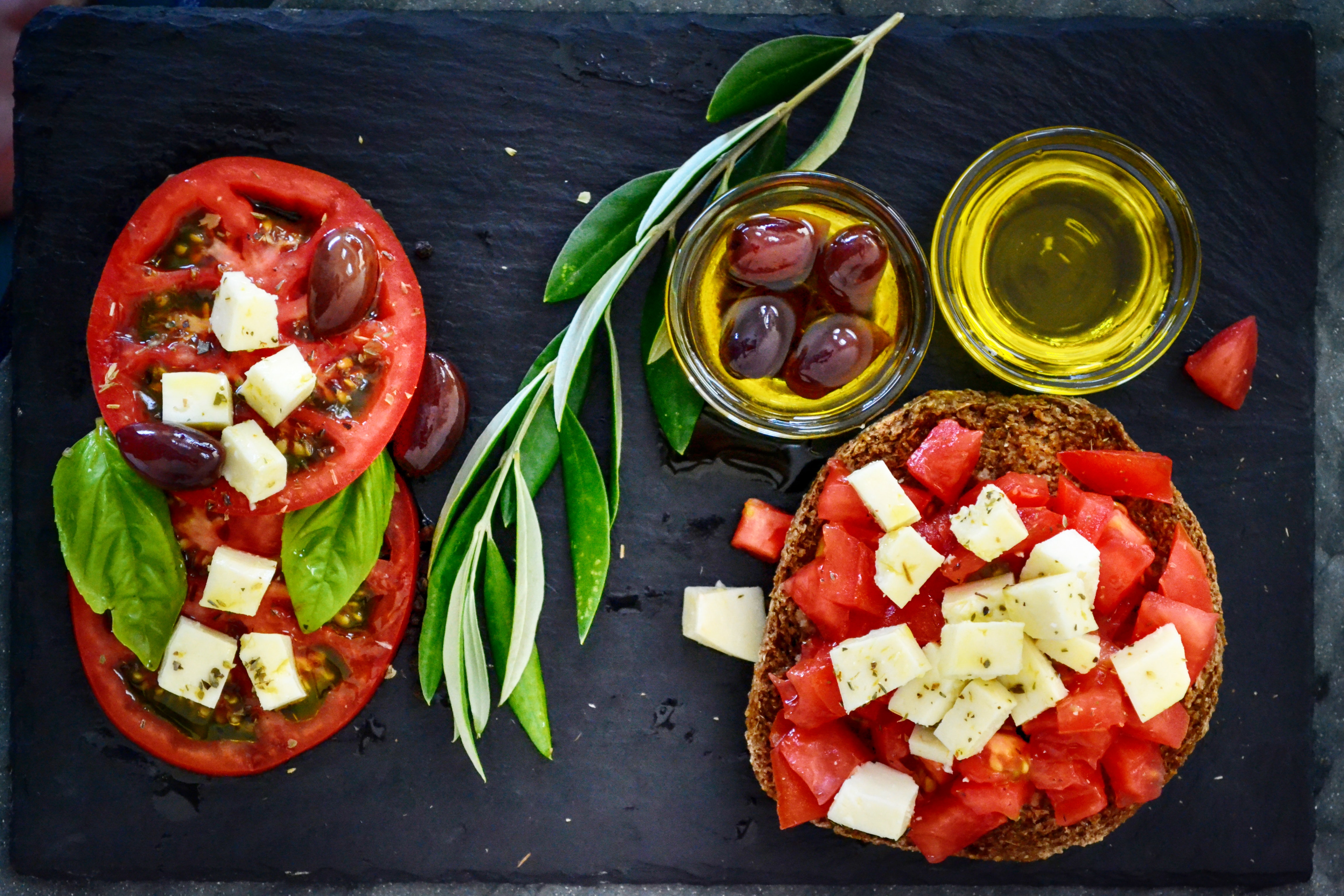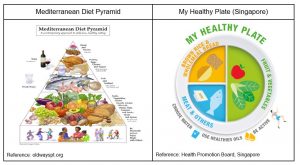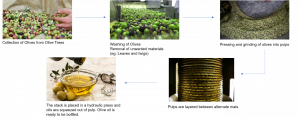
Why is Mediterranean Diet popular?
Written by: Gloria Lek
What is the Mediterranean Diet?
Traditional Mediterranean diets are based on a high intake of a wide range of fruit and vegetables, nuts and legumes, and unrefined cereals. Fish and dairy foods are eaten regularly, while red meat, other saturated fats and poultry are consumed only occasionally. Olive oil is the foremost source of fat in the Mediterranean area and, it sets the Mediterranean diet apart from other dietary regimens.
Why has it become popular through the years?
The Mediterranean Diet has gained popularity as there has been many scientific studies published about the less-known benefits of the diet (Martínez-González,2015). In one, men who followed the diet had a lower risk of aggressive prostate cancer (Stacey, 2014), and in the other, long-time diet followers had a reduced risk of becoming frail in old age (Luz, 2014). Long-term studies have found that people who follow a Mediterranean-style diet are less likely to develop cardiovascular disease (Salas-Salvadó,2018), diabetes (Salas-Salvado,2014) and kidney disease (Khatri, 2014), to name a few. The Mediterranean diet focuses on foods that have anti-inflammatory and antioxidant properties and thus is crucial for the prevention of diseases. The med-diet may offer cardiovascular protection by regulating blood pressure and insulin sensitivity and providing resistance to oxidation, inflammation and vasoreactivity. The PREDIMED study (Martínez-González,2015) showed with a randomized control trial design for the first time that a Mediterranean diet supplemented with either extra-virgin olive oil is useful in the primary prevention of cardiovascular disease, peripheral artery diseases, atrial fibrillation (irregular heartbeat), and type 2 diabetes in individuals at high risk. Similarly, the interventions were shown to reduce blood pressure and the risk of Hypertension as well as to slow down the progression of subclinical atherosclerosis, as determined by changes in ultrasound-assessed carotid intima-media thickness and plaque.
How does the Mediterranean Diet compare to Singapore’s recommended diet?

Where the two diets meet?
- Both diet pyramids have emphasis on a balanced diet with wholemeal products, meats, fruits and vegetables included on a daily basis.
- In the Mediterranean Diet, olive oil is the predominant oil used while in the My Healthy Plate, usage of healthier oils are advised with no particular type of oils indicated.
- Both diets encourage consumption of more white meat as compared to red meats.
- In the Mediterranean Diet, proteins are divided into no less than three categories, with chicken grouped with dairy products, and red meat at the top with sweets.
- Under the category of “Meats and others” in the My Healthy Plate, lean meats such as chicken and fish are preferred comparatively to red meats. Leaner cuts of meat provide more protein per calorie than fatty meats.
- Both calls for a healthy physically active lifestyle and choosing water whenever possible.
Flowchart of key steps to making Olive Oil

Have you wondered what’s the difference between extra virgin, extra light and pure/classic olive oil? How is one option better than the other?
The varieties of olive oil are due to the following:
- Type of olive used
- How the olives are harvested (ripeness of olive and time between harvest and pressing process)
- Method by which olives are pressed, stored and package
The oil itself is graded by the amount of oleic acid it contains. More oleic acid means that more of the oil has broken down into fatty acids as a result of thermal or chemical production methods. So, the different grades of olive oil are as follows:
Grades of olive oil
When no heat is applied in the pressing, the product can be termed “first cold pressed.” The temperature of this product cannot exceed 27 °C or else it will lose value. The oil can settle, and any vegetable water is removed either by centrifuge or decantation. The visual colour of the olive oils reduces in intensity as the quality decreases.
| Extra Virgin Olive Oil | Virgin Olive Oil | Classic/Pure Olive Oil | Light and extra light olive oils |
|
|
|
|
You might be glad to know that despite the difference in quality of the various olive oils, in terms of nutritional content, all types of olive oils are similar. A tablespoon of olive oil contains 120 calories, 14 grams of fat, and no cholesterol. About 10g (~55 to 85 percent) of the fat in olive oil is monounsaturated, 2g is polyunsaturated fat and 2g is vegetable-derived saturated fat. Additionally, Virgin olive oils also contain the antioxidants beta-carotene and Vitamin E, as well as the phenolic compounds tyrosol and hydroxytyrosol.
Smoking Point of Olive Oil
The smoke point for various olive oil differs. The smoke point of olive oil increases as the number of processing used to process the oils increases.
- For example, among the 4 types of olive oils compared above, extra light olive oil has the highest smoke point of 242°C. Extra virgin olive oil (EVOO) has the lowest smoking point of 160°C.
However, in the market, there has been a type of EVOO that has a reasonably high smoke point and high stability. It is the Cobram Olive Oil series. It has a smoke point of between 200°C and 215°C (Cobram Estate, 2018). The ability to withstand high temperatures is due to lower free fatty acid content that results from the types of olive fruit grown on their farms. Compared to the average EVOOs in the market, it has a high combination of high monounsaturated fatty acids (MUFA) and low polyunsaturated fatty acids (PUFA), together with the rich antioxidants properties found in olive oils, it is highly resistant to oxidation and thus it forms a barrier for harmful substances to form upon application of heat through cooking and a longer storage lifespan. Furthermore, when fatty foods are cooked in EVOO, there is an increase in the foods’s MUFA content and a reduction in the saturated fatty acid and PUFA content.
Olive oils can be found easily at all supermarkets in Singapore.
The lists below shows the brands as well as the controlled prices of olive oil found at the local supermarkets (last updated 24 August 2018) :
| Legend for the availability of product:
* was found at both NTUC FairPrice and Cold Storage # was found at NTUC FairPrice ^ was found at Cold Storage |
| EXTRA VIRGIN OLIVE OIL | |||
| Name of product | Price ($) / bottle | Price/100ml | Uniqueness |
| 1. ALCE NERO Organic Olive Oil – Extra Virgin *
|
10.90/250ml
15.45/500ml |
4.40
3.10 |
Best for light dishes such as grilled fish and salad dressing |
| 2. BERTOLLI Olive Oil – Extra Virgin Rich Taste *
|
11.35/500ml
21.70/1 L 40.00/2 L |
2.30
2.20 2.00 |
Ideal for dressings, salads, marinades, bread dipping and as a finishing oil for every type of cuisine. |
| 3. BERTOLLI Olive Oil – Extra Virgin Gentle Taste * | 11.10/500ml | 2.20 | Ideal for pasta and fish |
| 4. BORGES Olive Oil – Extra Virgin *
|
9.40/500ml
17.90/1 L 30.90/2L |
1.90
1.80 1.50 |
Ideal for dressings |
| 5. COBRAM ESTATE extra virgin olive oil # | 7.90/ 375ml | 2.10 | Olives are cold pressed within 6 hours |
| 6. COLAVITA extra virgin olive oil ^ | 9.20/250ml | 3.70 | Slightly spicy and bitter |
| 7. FAIRPRICE Olive Oil – Extra Virgin # | 8.95/500ml
16.10/ 1L 27.80/2 L |
1.80
1.60 1.40 |
Healthier Choice.
Best used served fresh or for dressing salad, pasta, meat, roast, fish |
| 8. FAIRPRICE Olive Oil – Extra Virgin (Organic) # | 11.95/500ml | 2.40 | Healthier Choice. |
| 9. JAMIE OLIVER extra virgin olive oil ^ | 12.90/500ml | 2.60 | – |
| 10. KENT BORINGER extra virgin olive oil ^ | 12.60/1 L | 1.30 | – |
| 11. NATUREL Olive Oil – Extra Virgin *
|
8.90/500ml
24.00/1.5L
|
1.80
1.60 |
Healthier Choice.
sweet, smooth taste with gentle hints of spiciness
|
| 12. NATUREL Organic Olive Oil – Extra Virgin * | 13.25/500ml | 2.70 | Healthier Choice.
Full-bodied flavour is smooth and sweet, with a lingering flavour of cut grass. Ideal as a dip or salad dressing |
| 13. OLITALIA unfiltered extra virgin olive oil ^ | 11.00/ 500ml | 2.20 | Recommended to crude dressings and cold dishes |
| 14. PAPA ALFREDO Extra Virgin Olive Oil *
15. PAPA ALFREDO Extra Virgin Olive Oil * |
7.95/500ml
12.95/1 L |
1.60
1.30 |
Ideal for dressings, marinates and dips |
| 16. RAVIKA early harvest extra virgin olive oil ^ | 12.50/500ml | 2.50 | – |
| 17. SUMICH extra virgin olive oil ^ | 7.90/500ml | 1.60 | Ideal for salad dressing and dips |
| 18. SPECTRUM Mediterranean extra virgin olive oil ^ | 23.90/ 1L | 2.40 | – |
| 19. WAITROSE Org olive oil extra virgin ^ | 21.95/500ml | 4.40 | – |
| 20. WAITROSE extra virgin olive oil ^ | 8.95/500ml | 1.80 | – |
| 21. WILD HARVEST extra virgin olive oil ^ | 12.95/502ml | 2.60 | – |
| EXTRA LIGHT OLIVE OIL | |||
| Name of product | Price ($) / bottle | Price/100ml | Uniqueness |
| 1. ALCE NERO Organic Olive Oil – Extra Virgin *
|
10.90/250ml
15.45/500ml |
4.40
3.10 |
Best for light dishes such as grilled fish and salad dressing |
| 2. BERTOLLI Olive Oil – Extra Virgin Rich Taste *
|
11.35/500ml
21.70/1 L 40.00/2 L |
2.30
2.20 2.00 |
Ideal for dressings, salads, marinades, bread dipping and as a finishing oil for every type of cuisine. |
| 3. BERTOLLI Olive Oil – Extra Virgin Gentle Taste * | 11.10/500ml | 2.20 | Ideal for pasta and fish |
| 4. BORGES Olive Oil – Extra Virgin *
|
9.40/500ml
17.90/1 L 30.90/2L |
1.90
1.80 1.50 |
Ideal for dressings |
| PURE/CLASSIC OLIVE OIL | |||
| Name of product | Price ($) / bottle | Price/100ml | Uniqueness |
| 1. BERTOLLI Olive Oil – Classico *
|
5.85/250ml
11.00/500ml 20.50/1 L |
2.30
2.20 2.05 |
For sauces, roasting and grilling |
| 2. BORGES Olive Oil – Classic *
|
8.45/500ml
16.20/ 1L |
1.70
1.60 |
Ideal for barbeque and grill |
| 3. BORGES Olive Oil – Pure * | 27.90/2 L | 1.40 | – |
| 4. FAIRPRICE Olive Oil – Rich & Fruity # | 7.95/500ml
14.55/ 1 L 25.10/ 2 L
|
1.60
1.50 1.30 |
Healthier Choice.
Complements and enhances the natural flavours of dishes |
| 5. KENT BORINGER 100% pure olive oil ^ | 11.50/1 L | 1.20 | |
| 6. MONINI pure olive oil Squeezable ^ | 8.55/450ml | 1.90 | Comes in squeezable bottle. Suitable for everyday cooking |
| 7. NATUREL Olive Oil – Pure *
|
11.90/750ml
26.90/2L |
1.60
1.30 |
Healthier Choice.
It is also lower in saturated fat. ideal for salads, pastas, marinades, sauces, grilling, roasting and pan-fried dishes. Its like “Classic” |
| 8. PAPA ALFREDO Classic Olive Oil ^ | 6.95/500ml
12.50/ 1 L |
1.40
1.30 |
Ideal for sauces, pasta and dressing |
| EXTRA VIRGIN OLIVE OIL (SPRAY) | |||
| Name of product | Price ($) / bottle | Price/100ml | Uniqueness |
| 1. Bertolli Extra Light Olive Oil Spray – Delicate * | 6.95/145ml | 4.80 | best for sautéing, frying and baking |
| 2. Bertolli Extra Light Olive Oil Spray – Rich * | 7.15/145ml | 4.90 | best for salads and pasta |
| 3. NATUREL Spray Oil – Extra Virgin * | 7.30/200ml | 3.65 | Healthier Choice.
allows you to smoothly distribute and control the amount of oil desired. It is lower in saturated fat while high in good fats |
| OLIVE OIL FLAVOURED OILS/SPRAY | |||
| Name of product | Price ($) / bottle | Price/100ml | Uniqueness |
| 1. MANTOVA Grand Aroma extra virgin olive oil Spray ^ | 13.75/227ml | 6.10 | Flavoured spray |
| 2. MANTOVA EVO OIL TRUFFLE SPRAY ^ | 13.75/227ml | 6.10 | Flavoured spray |
| 3. NATUREL Spray Oil – Avocado Olive * | 7.30/200ml | 3.65 | Healthier Choice. Flavoured spray. Allows smooth distribution and control the amount of oil desired. It is lower in saturated fat while high in good fats |
| 4. NATUREL extra virgin olive oil – basil flavoured*
5. NATUREL extra virgin olive oil – oregano flavoured* 6. NATUREL extra virgin olive oil – lemon flavoured* 7. NATUREL extra virgin olive oil – white truffle flavoured* 8. NATUREL extra virgin olive oil – rosemary flavoured* 9. NATUREL extra virgin olive oil – saffron flavoured* |
8.50/250ml | 3.40 | Healthier choice.
Flavoured oils |
- As you can see from the tables above, Classic/pure and extra light olive oil under the same brand are rather similar in price. So, you might want to consider getting Classic/pure as it is of a higher quality and can be used for more forms of cooking.
On the Mediterranean diet, about 30 to 40 percent of calories come from fats, including olive oils and sources such as fatty fish and nuts. Therefore, depending on your calorie consumption, you can allot for different amounts. Table 2 gives an example of the amount of fats (in grams) you should eat daily, based on the total number of calories consumed per day (University of Massachusetts Amherst). The amount of fat in grams from olive oil equates to about half of your fat needs.
| Calories per day | Total fats a day (in grams) | Suggested olive oil consumption |
| 1600 | 53 | 2 tablespoons ~(26grams) |
| 2000* | 65 | 2-3 tablespoons ~(32 grams) |
| 2500 | 80 | 3 tablespoons ~(40 grams) |
| 2800* | 93 | 3-4 tablespoons ~(46 grams) |
Table 2: How much olive oil should you eat?
*Percent Daily Values on Nutrition Facts Labels are based on a 2,000 calorie diet. Values for 2,000 and 2,500 calories are rounded to the nearest 5 grams to be consistent with the Nutrition Facts Label.
Conclusion
In conclusion, more than just a way of eating, the Mediterranean Diet is a lifestyle that is practiced in countries along the Mediterranean. But what’s notable about this diet is the central role played by vegetables, fruit, fish, cheese, wine and, of course, Extra Virgin Olive Oil, its key ingredient, as shown in its food pyramid. Based on your price point and method of cooking, pick up a bottle of olive oil from your local supermarket now!
References
- Berman, R. (2013). Mediterranean diet for dummies. Hoboken, NJ: John Wiley.
- Buy Groceries Online. (n.d.). Retrieved from https://coldstorage.com.sg/
- Cobram Estate. (n.d.). Australia’s No.1 Extra Virgin Olive Oil. Retrieved from https://cobramestate.com.au/
- Dietary Guidelines: Choose Sensibly. (n.d.). Retrieved from http://k12s.phast.umass.edu/abc/USDA_guide/choose.htm
- FairPrice: Online Grocery Shopping & Delivery in Singapore. (n.d.). Retrieved from https://www.fairprice.com.sg/
- Kenfield, S. A., Dupre, N., Richman, E. L., Stampfer, M. J., Chan, J. M., & Giovannucci, E. L. (2014). Mediterranean Diet and Prostate Cancer Risk and Mortality in the Health Professionals Follow-up Study. European Urology, 65(5), 887-894. doi:10.1016/j.eururo.2013.08.009
- León-Muñoz, L. M., Guallar-Castillón, P., López-García, E., & Rodríguez-Artalejo, F. (2014). Mediterranean Diet and Risk of Frailty in Community-Dwelling Older Adults. Journal of the American Medical Directors Association, 15(12), 899-903. doi:10.1016/j.jamda.2014.06.013
- Khatri, M., Moon, Y. P., Scarmeas, N., Gu, Y., Gardener, H., Cheung, K., . . . Elkind, M. S. (2014). The Association between a Mediterranean-Style Diet and Kidney Function in the Northern Manhattan Study Cohort. Clinical Journal of the American Society of Nephrology, 9(11), 1868-1875. doi:10.2215/cjn.01080114
- Salas-Salvadó, J., Becerra-Tomás, N., García-Gavilán, J. F., Bulló, M., & Barrubés, L. (2018). Mediterranean Diet and Cardiovascular Disease Prevention: What Do We Know? Progress in Cardiovascular Diseases. doi:10.1016/j.pcad.2018.04.006
- Martínez-González, Salas-Salvadó, Estruch, Corella, Fitó, Ros (2015) Benefits of the Mediterranean Diet: Insights From the PREDIMED Study Progress in Cardiovascular Diseases. doi:10.1016/j.pcad.2018.04.006


